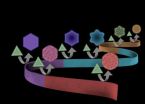(Press-News.org) Breast cancers that depend on the hormones estrogen and progesterone are susceptible to treatments targeting these hormones. Take away this dependence and you lose a valuable treatment option. A University of Colorado Cancer Center study published as a featured article in the journal Oncogene shows how progesterone does just this – by suppressing a key microRNA, progestins return breast cancer cells to a stem-cell-like state in which they haven't yet differentiated, and are thus more resistant to chemotherapies and more likely to carry a poor prognosis.
"The reason we were looking into the possible role of microRNAs in the dedifferentiation of breast cancer cells into this aggressive, chemo-resistant phenotype is that microRNAs tend to be good, druggable targets. Because one microRNA may regulate many genes involved in a cancerous signaling pathway, we hoped to find one target with many beneficial effects," says Diana Cittelly, PhD, postdoctoral fellow at the CU Cancer Center and the paper's first author. The study was a collaboration between the CU Cancer Center labs of Jennifer Richer, PhD, and Carol Sartorius, PhD.
Specifically, the study shows that progestins regulate miRNA-29 – a molecule that helps to decide which of a cell's genes are and are not turned into proteins. This regulation of miRNA-29 creates a cascade that stimulates breast cancer cells to revert back to a stem-like state, marked by proteins CD44 and CK5. In animal models, these stem-like cells helped breast cancer evolve around the blockages of current treatments..
"We can manipulate this miRNA-29 in cell lines," Cittelly says, "and we hope technology isn't too far in the future that will allow us to deliver miRNA-29 in human cancers as well."
Turn off the role of miRNA-29 and the hope is that breast cancers won't be able to gain stem cell-like traits and lose their hormone dependence.
### END
The making and unmaking of stem-like, aggressive breast cancer cells
Returning to a stem-cell-like state helps breast cancer cells evade treatment
2012-08-09
ELSE PRESS RELEASES FROM THIS DATE:
New 3-D map of massive galaxies, distant black holes offers clues to dark matter and energy
2012-08-09
The Sloan Digital Sky Survey III (SDSS-III) has released the largest-ever three-dimensional map of massive galaxies and distant black holes, helping astronomers better explain the mysterious "dark matter" and "dark energy" that make up 96 percent of the universe. According to SDSS-III scientific spokesperson and University of Pittsburgh assistant professor of physics and astronomy Michael Wood-Vasey, scientists using the map—titled Data Release 9 (DR9)— can retrace the Universe's history over the last seven billion years. Wood-Vasey cowrote the DR9 summary paper featured ...
Chronic exposure to staph bacteria may be risk factor for lupus, Mayo study finds
2012-08-09
ROCHESTER, Minn. -- Chronic exposure to even small amounts of staph bacteria could be a risk factor for the chronic inflammatory disease lupus, Mayo Clinic research shows. Staph, short for Staphylococcus aureus, is a germ commonly found on the skin or in the nose, sometimes causing infections. In the Mayo study, mice were exposed to low doses of a protein found in staph and developed a lupus-like disease, with kidney disease and autoantibodies like those found in the blood of lupus patients.
The findings are published online this month in The Journal of Immunology. ...
Astronomers release the largest ever 3-D map of the sky
2012-08-09
VIDEO:
This is an animated flight through the universe as seen by SDSS. There are close to 400,000 galaxies in the animation, which places zoomed-in images of nearby galaxies at the...
Click here for more information.
The Sloan Digital Sky Survey III (SDSS-III) has released the largest three-dimensional map of massive galaxies and distant black holes ever created. The new map pinpoints the locations and distances of over a million galaxies. It covers a total volume equivalent ...
Wiki where you work?
2012-08-09
Do corporate wikis work? Two University of Alberta researchers say they can, providing they fit the corporation's culture and provide for the needs and interests of their users and editors.
PhD candidate Lisa Yeo and Ofer Arazy, an assistant professor in the Alberta School of Business, say that using wikis as a form of corporate knowledge management can be beneficial. However, some concessions need to be made in terms of how wiki "knowledge" is posted to support people's needs for recognition with their company. If companies want their wiki to work, it cannot be held ...
Simple mathematical computations underlie brain circuits
2012-08-09
CAMBRIDGE, MA -- The brain has billions of neurons, arranged in complex circuits that allow us to perceive the world, control our movements and make decisions. Deciphering those circuits is critical to understanding how the brain works and what goes wrong in neurological disorders.
MIT neuroscientists have now taken a major step toward that goal. In a new paper appearing in the Aug. 9 issue of Nature, they report that two major classes of brain cells repress neural activity in specific mathematical ways: One type subtracts from overall activation, while the other divides ...
Hyenas that think outside the box solve problems faster
2012-08-09
EAST LANSING, Mich. — Innovative problem solving requires trying many different solutions. That's true for humans, and now Michigan State University researchers show that it's true for hyenas, too.
The study, published in the current issue of the Proceedings of the Royal Society B, presented steel puzzle boxes with raw meat inside to wild spotted hyenas in Kenya. To get the meat, the hyenas had to slide open a bolt latch. Even though most of the animals had many opportunities to open the box, only nine out of 62 hyenas succeeded. The successful hyenas tried more solutions, ...
Study shows official measures of American poverty off-base
2012-08-09
For more than 45 years, the poor in this country have been identified by the U.S. Census Bureau's Official Poverty Measure — a tool that determines America's poverty rate based on pretax money income, which does not reflect all the resources at a family's disposal.
That method of calculating who is poor and who is not has been under fire by researchers for years because it doesn't calculate the benefits of anti-poverty programs — such as food stamps and housing subsidies — into its formula. In response to the criticism, the Census Bureau released in fall 2011 the Supplemental ...
Iron, vitamins could affect physical fitness in adolescents
2012-08-09
Bethesda, Md. (Aug. 8, 2012)—Adolescence is an important time not only for growing but for acquiring healthy habits that will last a lifetime, such as choosing foods rich in vitamins and minerals, and adopting a regular exercise regimen. Unfortunately, several studies have shown that adolescents' intake of important nutrients, as well as their performance on standard physical fitness tests, has fallen in recent years. Because nutrition and fitness are intertwined—for example, iron forms part of hemoglobin, which carries oxygen to muscles, and antioxidants such as vitamin ...
Adolescents in substance abuse programs report using other's med marijuana
2012-08-09
AURORA, Colo. – (Aug. 8. 2012) - A recent study by University of Colorado School of Medicine researchers shows that it is very common for adolescents in substance abuse treatment to use medical marijuana recommended to someone else (also known as "diverted" medical marijuana).
Stacy Salomonsen-Sautel, PhD, a postdoctoral fellow in the CU School of Medicine's Department of Pharmacology and her colleagues in the Department of Psychiatry looked at two adolescent substance abuse treatment programs in the Denver metropolitan area. The study participants were asked questions ...
Oh, my stars and hexagons! DNA code shapes gold nanoparticles
2012-08-09
CHAMPAIGN, Ill. — DNA holds the genetic code for all sorts of biological molecules and traits. But University of Illinois researchers have found that DNA's code can similarly shape metallic structures.
The team found that DNA segments can direct the shape of gold nanoparticles – tiny gold crystals that have many applications in medicine, electronics and catalysis. Led by Yi Lu, the Schenck Professor of Chemistry at the U. of I., the team published its surprising findings in the journal Angewandte Chemie.
"DNA-encoded nanoparticle synthesis can provide us a facile but ...
LAST 30 PRESS RELEASES:
Australian team discover why quantum computers have memory problems over time
What determines the fate of a T cell?
Candida auris: genetic process revealed which could be treatment target for deadly fungal disease
Groundbreaking discovery turns household plastic recycling into anti-cancer medication
Blocking a key inflammatory pathway improves liver structure and vascular function in cirrhosis, study finds
Continuous spread: Raccoon roundworm detected in nine European countries
HKUST Engineering researchers developed a novel photodetector to enhance the performance of on-chip light monitoring
Strategic river sensors could have forewarned of Texas Camp flood disaster
Drone sampling of whale breath reveals first evidence of potentially deadly virus in Arctic
Roman soldiers defending Hadrian’s Wall infected by parasites, study finds
Pinochet’s prisoners were tormented with music but still found solace in it, a new book reveals
Fertility remains high in rural Tanzania despite access to family planning
AI-assisted device can improve autism care access
Kinetic careers
Uncovering how parasitic plants avoid attacking themselves to improve crop resistance
Nanoparticle vaccine strategy could protect against Ebola and other deadly filoviruses
Study finds brain care score can predict risk of stroke across racial groups
Key lung immune cells can intensify allergic reactions
Do hormones explain why women experience more gut pain?
New materials conduct ions in solids as easily as in liquids
Breakthrough of the Year: Renewable energy begins to eclipse fossil fuel-based sources
LLM use is reshaping scientific enterprise by increasing output, reducing quality and more
Introducing LightGen, a chip for ultra-fast, ultra-efficient generative AI
Astronomers see fireworks from violent collisions around nearby star
ACC/AHA issue new guideline on managing congenital heart disease in adults
Cosmic crash caught on camera
Is talented youth nurtured the wrong way? New study shows: top performers develop differently than assumed
Ants: An untapped resource in the development of antibiotics?
Archaeologists use AI to create prehistoric video game
Mitochondria migrate toward the cell membrane in response to high glucose levels
[Press-News.org] The making and unmaking of stem-like, aggressive breast cancer cellsReturning to a stem-cell-like state helps breast cancer cells evade treatment

